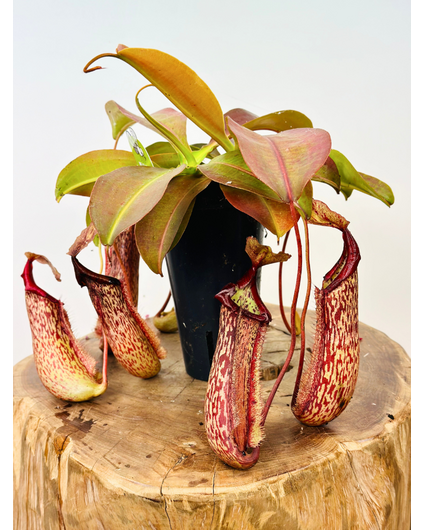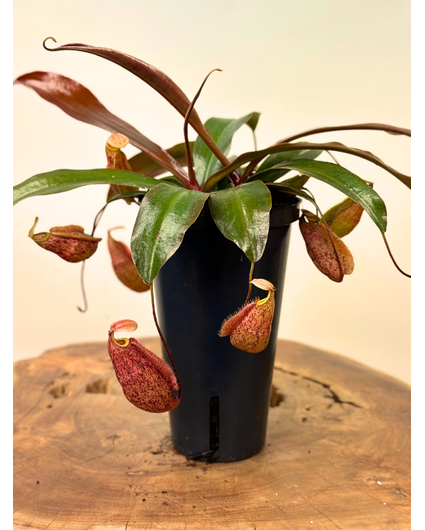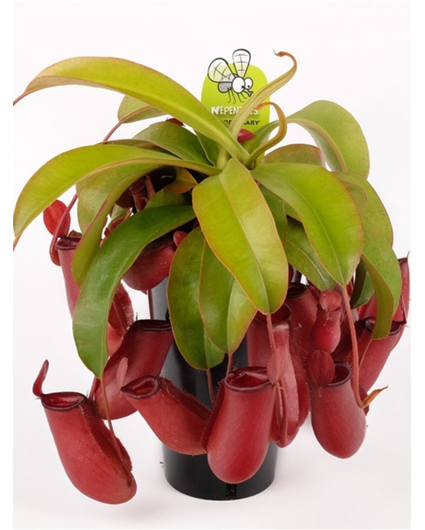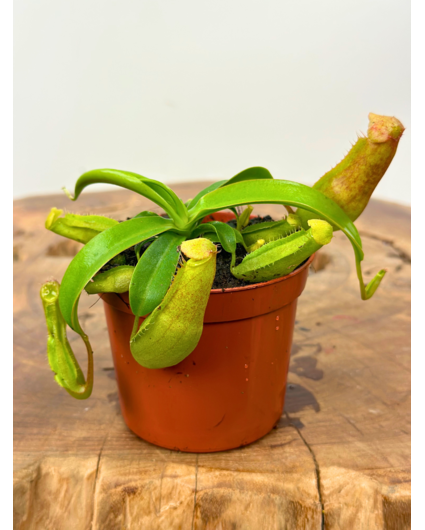Nepenthes (Pitcher plant )
Pitcher plant (Nepenthes) have the most unusual shapes, the most beautiful colours and the nicest characteristics. With a little care, these plants can grow very large.
Nepenthes "Alata" - large | ø 12 cm x ↕ 15 cm
INSECT-EATING PLANT
10% Save
€ 19,99 € 17,99*
* Incl. tax Excl. Shipping costs
Nepenthes "Miranda" - large | ø 12 cm x ↕ 15 cm
€ 18,99*
* Incl. tax Excl. Shipping costs
Nepenthes "Gaya" - large | ø 12 cm x ↕ 15 cm
INSECT-EATING PLANT
10% Save
€ 19,99 € 17,99*
* Incl. tax Excl. Shipping costs
Nepenthes "x Suki" - large | ø 12 cm x ↕ 15 cm
€ 17,99*
* Incl. tax Excl. Shipping costs
Nepenthes "Hookeriana" | ø 8,5 cm x ↕ 5 cm
INSECT-EATING PLANT
8% Save
€ 11,99 € 10,99*
* Incl. tax Excl. Shipping costs
Nepenthes "Bloody Mary" - large | ø 12 cm x ↕ 15 cm
INSECT-EATING PLANT
22% Save
€ 22,99 € 17,99*
* Incl. tax Excl. Shipping costs
Nepenthes "Gaya" | ø 8,5 cm x ↕ 5 cm
INSECT-EATING PLANT
€ 10,99*
* Incl. tax Excl. Shipping costs
Heat Packs
€ 1,80*
* Incl. tax Excl. Shipping costs
Nepenthes "Bloody Mary" | ø 8,5 cm x ↕ 5 cm
INSECT-EATING PLANT
€ 10,99*
* Incl. tax Excl. Shipping costs
Nepenthes "Singalana x Ventricosa" - large | ø 12 cm x ↕ 15 cm
€ 19,99*
* Incl. tax Excl. Shipping costs
Nepenthes "Singalana" | ø 8,5 cm x ↕ 5 cm
INSECT-EATING PLANT
€ 11,99*
* Incl. tax Excl. Shipping costs
Nepenthes "Miranda" - small | ø 8,5 cm x ↕ 5 cm
€ 11,99*
* Incl. tax Excl. Shipping costs
- 1500+ ratings
- Best quality: directly from nursury
- Shipped within in 1 working day

The pitcher plant (Nepenthes) belongs to the Nepenthaceae family. The pitcher plant belongs to the tropical plants. The plant owes its name to its unique appearance and large 'cups'. The Nepenthes has a beautiful coloured cup shape and is therefore also called 'Cup plant'.
Nepenthes: The trap
The pitcher plant lures its prey (insects) with a delicious nectar-scent. Because the pitcher plant eats insects, it is also called a carnivorous plant. At the top of the inside of the pitcher leaf there is a smooth edge. The function of the smooth edge is that an insect has no grip and therefore slides into the cup. Inside the pitcher itself there are solid hairs that are directed downwards. The purpose of these hairs is that the prey cannot escape. At the bottom of the pitcher of Nepenthes there is a viscous liquid full of digestive juices (enzymes). The digestive juices are produced by glands on the inside of the pitcher. Some pitchers of Nepenthes species can grow to 50cm in size!
Pitcher plant origin
The Nepenthes can be found in different parts of the world. The pitcher plant is mostly found in Southeast Asia (Borneo). It is also found in Sri Lanka, Madagascar and the Seychelles. Due to its carnivorous lifestyle, the pitcher plant is able to live in nutrient-poor soil. The pitchers can lie low on the ground or hang high in the air. Most pitcher plants grow in tropical hillside forests. These forests have large temperature differences. However, there are also chalice plants that grow in the wet lowlands. In the lowlands it is warm during the day and at night. There are also pitcher plants that can be found at altitudes of up to 3000 metres. These are 'highland' Nepenthes.
Pitcher plant properties
The pitcher plant can grow up to 2 metres tall! This depends on the environment and care of the carnivorous plant. A climbing pitcher plant in the wild can grow up to 15 metres high. The pitcher plant likes the sun very much. However, it is important that the plant is not placed in direct sunlight. The pitcher plant also likes moisture, a lot in fact. The pitcher plant can also produce beautiful yellow/brown flowers in the form of bunches. The pitcher plant can be kept in a hanging pot as well as a standing pot. It is important, however, that the plant has room. In contrast to the Venus fly trap and the pitcher plant, the pitcher plant (Nepenthes) does not need a winter rest. Do you want to know more about the care of the pitcher plant? Take a look at our care tips, so you can enjoy this beautiful plant for years to come.
Would you like to buy a pitcher plant? Then look at our assortment.
Nepenthes trivia
Fact 1: The impressive name 'carnivorous plant' really does come into its own for Nepenthes. Most carnivorous plants catch insects, but with some large pitcher plant species (Nepenthes Rajah & Nepenthes Rafflesiana), with pitchers up to 50cm in size, other (small) animals are also its prey. Rats, for example, are on the menu of this carnivorous plant. Fact 2: The Nepenthes is also sometimes called 'monkey cup'. This is because monkeys have been seen drinking from the cups of the cup plant.













